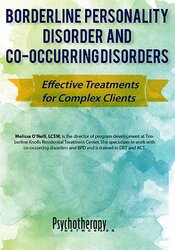

We now know that along with accompanying mood disorders, 78 percent of adults with borderline personality disorder (BPD) will develop a substance disorder or addiction at some point. Understanding and addressing this complex comorbidity can make treating these clients less overwhelming. Through experiential exercises and case studies, we’ll explore how personal biases toward clients with BPD can affect diagnosis, treatment, and outcomes, and we’ll focus on a range of evidence-based practices for treating this complex diagnosis. You’ll discover how to:
Cultivate awareness of personal biases to avoid common traps with BPD clients, such as blaming the client and getting caught in their narrative
| File type | File name | Number of pages | |
|---|---|---|---|
| Manual - Borderline Personality Disorder and Co-Occurring Disorders (1.2 MB) | 21 Pages | Available after Purchase |
Melissa O’Neill, LCSW, is the director of program development at Timberline Knolls Residential Treatment Center. She specializes in work with co-occurring disorders and BPD and is trained in DBT and ACT.
Please wait ...